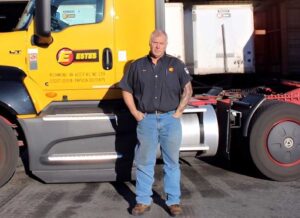When the Federal Motor Carrier Safety Administration (FMCSA) announced its Safe Driver Apprenticeship Pilot Program, a product of the Bipartisan Infrastructure Law enacted in 2021, the trucking industry breathed a long-overdue sigh of relief.
At last, many thought, Washington had heard the industry’s pleas to create some path to allow drivers under 21 to operate in interstate commerce as a means to help ease the pervasive driver shortage.
In the time since, however, the program has sputtered, attracting participation by only a handful of carriers. Virtually no small companies, which some believe the bill would benefit most, have stepped up to take part.
Critics blamed the low response to what they described as excessive regulatory and reporting requirements in the program. The most criticized portions of which were requirements for participating carriers to register with the Department of Labor, mandating driver-facing cameras in the cab, and reporting requirements.
Whatever the reason, the apprenticeship pilot was widely panned and appeared to be headed for the scrap heap.
Not so fast, say some carriers who have given the program a try.
Tim Chrulski, COO of Ohio-based Garner Trucking, a participant in the pilot program, says his company didn’t take much issue with the requirements of the program as written.
“The program itself is one that, frankly, I’ve believed in for a long time,” he said.
“Before all of this even started, we put together an apprenticeship program of our own so we could at least train drivers under the age of 21 to be able to operate in the state of Ohio,” he shared. “So, when this program came to fruition, it was extremely exciting for our organization. I think this is one of the best things to happen to the industry in a long time.”
Some naysayers may be focusing on the wrong things.
“First and foremost, the most important thing is that we have safe drivers driving tractor-trailers, because my family and your family are out on the same road sharing the same highways,” Chrulski said.
“I think the way that the program is structured, with the amount of hours that you have to complete, the accountability for reporting, and the need for safety equipment inside the trucks — all of those things are beneficial, and really very productive for the program,” he said.
New York-based Leonard’s Express was another early adopter of the apprentice program.
Ken Johnson, the carrier’s CEO, says that, even before the pilot program was launched, the New York state trucking industry was already working on issues.
“We were one of those few states that didn’t allow 18-year-olds to get their Class A, so we worked hard on getting that done,” he shared. “A lot of the reason we did it was because we knew that there was the possibility of the pilot program coming through from the federal government. We wanted New York state carriers to be able to participate in it.”
Johnson says his company had no issue with the pilot’s requirements, having already established its own independent driving school, ensuring it was carrying the necessary insurance and equipping all of its trucks with cameras.
“The only thing that we had to do was put the proper training parameters in place. It wasn’t that big of a hurdle for us to overcome,” he said.
“Having never been involved in a federal government pilot program before, we really didn’t know what to expect,” Johnson continued. “Some of the rules that came out of DOT we thought stretched it some, but we also didn’t think that they were so stretched that we couldn’t achieve the goal.”
The Safe Driver Apprenticeship Pilot Program is the most proactive attempt yet to produce safe, qualified younger drivers for interstate operation. The program outlines a training pathway by which 18- to 20-year-old apprentices complete two probationary periods. In addition, specific educational requirements must be completed as laid out in the program guidelines.
Both Chrulski and Johnson believe that whatever shortcomings the program might have had were miniscule compared to the issue it was created to address. The industry’s driver shortage stretches back decades and is consistently cited as the biggest challenge facing the industry in terms of current capacity and future growth. Having a workable mechanism that safely moves young people into interstate driver jobs earlier is worth jumping through a few hoops, they said.
“I hope they convert the pilot to where everyone can participate in it. I think it’s heading in the right direction,” Johnson said.
“It’s imperative for the industry to have this to start attracting younger people. If you go to our typical first day of class at our driving school and you look around, it’s clearly people in their second or third careers,” he continued. “We need to find ways to lower the age and bring in people for whom trucking is a first career choice. I think the program provides that.”
This spring, proponents of the pilot got some good news as the FMCSA issued an emergency request to the Office of Management and Budget for approval of program revisions. The request dropped the inward-facing camera requirement and mandatory registration with the Department of Labor.
Hopefully, the changes will eliminate any remaining barriers and open the pilot program to wider participation across the U.S.
“I personally believe that if you are going to have a complete picture of what’s going on behind the wheel you need that camera inside the truck anyway, and I think the amount of reporting is quite necessary as a part of the program,” Chrulski said.
However, he noted, if the camera requirement was the deciding factor for a motor carrier to not participate in the apprentice program, that the FMCSA made a worthwhile decision.
“I don’t know that there’s been anything I’ve been more passionate about than this apprenticeship program in all my years of trucking,” Chrulski said.
“I just think this is the right decision for our industry and I just want to encourage other companies to embrace this and figure it out for themselves,” he continued.” I’m willing to help where I can and give some guidance where I can, because I just think this is the right thing to do for our industry.”
Dwain Hebda is a freelance journalist, author, editor and storyteller in Little Rock, Arkansas. In addition to The Trucker, his work appears in more than 35 publications across multiple states each year. Hebda’s writing has been awarded by the Society of Professional Journalists and a Finalist in Best Of Arkansas rankings by AY Magazine. He is president of Ya!Mule Wordsmiths, which provides editorial services to publications and companies.














